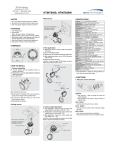Download User Manual - Cyfrowe.pl
Transcript
User Manual Thank you for buying a Samsung camera. This manual will guide you through using the camera, including capturing images, downloading images and using the application software. Please read this manual carefully before using your new camera. ENGLISH ZOOM W / T button ● WIDE Zoom INFORMATION Optical zoom WIDE : Pressing the ZOOM W button. This will zoom out from the subject i.e. the subject will appear farther away. Pressing the ZOOM W button continuously will set the camera to its minimum zoom setting i.e. the subject appears at its farthest from the camera. Pressing the ZOOM W button Pressing the ZOOM W button 7 7 7 [TELE zoom] [Optical zoom 2X] Digital zoom WIDE Digital zoom Optical zoom : When the digital zoom is in operation, pressing the ZOOM W button will reduce the digital zooming in steps. Releasing the ZOOM W button stops digital zooming.Pressing the ZOOM W button will reduce the digital zoom and then it will continue to reduce the optical zoom until the minimum setting is reached. Pressing the ZOOM W button Pressing the ZOOM W button 7 [Digital zoom 5X] [WIDE zoom] ● Images taken using the digital zoom may take a little longer for the camera to process. Allow time for this to take place. ● You may notice a decrease in image quality when using the digital zoom. ● To view a clearer digital zoom image, press the shutter button halfway at the maximum optical zoom position and press the zoom T button again. ● The digital zoom can’t be activated in the ASR, High Speed, [Night], [Children], [Text], [Close up] and [Fireworks] scene modes. ● Take care not to touch the lens to avoid taking an unclear image and possibly causing camera malfunction. If the image is dim, turn the camera power off and on again to modify the lens position. ● Avoid putting pressure on the lens as this may cause a camera malfunction. ● When the camera is turned on, take care not to touch the camera's moving lens parts as this may cause the resulting image to be dim and unclear. 7 [TELE zoom] 7 [WIDE zoom] 《23》 Using the LCD monitor to set the camera ■ You can use the menu on the LCD monitor to set up recording functions. (O : Selectable, X : Not selectable, - : Partly selectable) MENU page COLOR O X X X X X X p.25 BRIGHT O X X X X X X p.25 FOCUS NORMAL O O O O X X O AUTO MACRO O X O X X X X MACRO X O X O X X O MANUAL FOCUS X O X X X X X O O O O O O O SIZE SHOOTING SINGLE X O O O O O X CONTINUOUS X O X X X X X MOTION CAPTURE X O X X X X X AEB X O X X X X X QUALITY O O O O O O O MOTIONTIMER O O O O O O X DOUBLE O O O O O O X 2SEC O O O O O O X 10SEC O O O O O O O TIMER 《24》 p.28 MULTI SPOT CENTER SHARPNESS METERING PHOTO FRAME COMPOSITE p.28 p.30 p.30 O O O O O O O VOICE O O O O O O O p.32 W/B X O X X X X O p.34 ISO X O X X X X X p.33 EV X O X X X X O p.33 OFF FLASH OFF SLOW SYNC FILL IN RED EYE AUTO RED EYE FIX p.26 page MENU HIGHTLIGHT NORMAL B&W SEPIA B EFFECT R G NEGATIVE CUSTOM O X X O X O X X X X X X X X X X X X X X X O O O O O O O O O O X X X O O O O O O O X O X X X X X X X X X X X X X X X X X X X X O O O O O O O O O O O O O O O O O O O O O O X X O X O X X X X X X X O O O O O O O X ※ Menus are subject to change without prior notice. ※ The selectable menus may vary in each scene modes. X X X X X X X X X X X X X X O O O X X X X O O O O O O O X p.27 p.29 p.29 p.35 p.35 p.37 p.30 Colour tone Brightness ■ You can add Colour tone on the captured image. The Warm menu will increase the red Colour of the image.The Cool menu will increase the blue Colour of the image. ■ You can change the brightness of the image. COLOR BRIGHT 7 7 ● Selecting the Colour tone To select the Colour tone, touch the button and slide your finger to the left or right. [Emphasizing the Cool-Colour] [Emphasizing the Warm-Colour] ● Changing the brightness To select the brightness, touch the button and slide your finger to the left or right. [Dark] [Bright] 《25》 Selecting focus type ■ You can select the focus type in accordance with the subject distance. The distance ranges are show below. INFORMATION ● When the macro mode is selected, it is possible that camera shake will occur. Take care not to shake the camera while taking a picture. ● When you take a picture within 40cm in the Macro mode, select the FLASH OFF mode. NORMAL(AF) MACRO MF MANUAL FOCUS 7 ■ Manual Focus (MF) Where the automatic focusing is not available, for example, in dark conditions, use manual focus. Please be careful when using manual focus; it is easy to take unsharp pictures! You can use manual focus in program mode. 7 7 [Auto] MF 7 7 4.5m [Manual] [Auto Macro] ● Types of focus modes and focus ranges (W : Wide, T : Tele) 《26》 ● How to set manual focus To change to manual focus, touch the button and slide your finger to the left or right. Press the horizontal smart button or shutter button to set manual focus. [Macro] Focus Type Focus range Normal W:80-Infinity 1.5m 80cm 40cm 5cm MF 4.5m 1.5m 80cm 40cm 5cm (Unit : cm) [Farther focus] Macro W:5-80 T:40-80 Auto macro W:5-Infinity T:40-Infinity Manual focus W:5-Infinity T:40-Infinity [Closer focus] MF Flash ■ You can select the flash type in accordance with the subject distance. The distance ranges are show below. ● Flash mode indicator RED EYE SLOW SYNC ■ When using the ASR, Continuous shot, Motion Capture, AEB, Movie clip mode and Scene modes except for the Night, Portrait, Children , Backlight, Beach&Snow scene modes, the flash will not operate. ■ Flash range (W : Wide, T : Tele) ISO AUTO Normal Menu tab FILL IN 7 (Unit : m) Auto macro W:0.8-3.0 Macro W:0.4-0.8 T:0.8-2.5 T:0.5-0.8 T:0.5-2.5 W:0.4-3.0 Flash mode Description When a shot with "red eye" is detected, this mode Red-eye reduction will reduce the red-eye effect automatically. OFF Manual focus W:0.4-3.0 Auto & Red eye reduction If a subject or background is dark, the camera flash will work automatically and will reduce the red-eye effect by using the red-eye reduction function. Fill in flash The flash fires regardless of the available light. The intensity of the flash will be automatically controlled to suit the prevailing conditions. Slow synchro The flash operates with a slow shutter speed to obtain a balanced correct exposure. In poor lighting conditions the camera shake warning indicator ( ) will display on the LCD monitor. Flash off The flash does not fire. Select this mode when capturing images in a place or situation where flash photography is prohibited. When you capture an image in a poorly lit condition, the camera shake warning indicator ( ) will display on the LCD monitor. Auto flash If the subject or background is dark, the camera flash will operate automatically. T:0.5-2.5 INFORMATION ● If you press the shutter button after selecting Auto, Fill-in, or Slow Synchro flash, the first flash fires to check the shooting condition (Flash range and Power ratio of flash). Do not move the camera until the second flash fires. ● Using the flash frequently will reduce the life of the battery. ● Under normal operating conditions the charging time for the flash is usually less than 4 seconds. If the battery is weak, the charging time will be longer. ● Take photographs within the flash range. ● The image quality is not guaranteed if the subject is too close or highly reflective. ● When taking flash pictures in poorly lit conditions, there may be white specks in the captured image. The specks are caused by the reflection of the flash light from atmospheric dust. It is not camera malfuction. 《27》 Setup menu [ File name ] [ Language ] ■ This function allows the user to select the file naming format. ■ There is a choice of languages that can be displayed on the LCD monitor. Even if the battery and AC charger are removed and inserted again, the language setting will be preserved. [Series] : New files are named using numbers that Series OSD Set Reset OSD Set follow the previous sequence, even when a File ◀ new memory card is used, or after Language formatting, or after deleting all pictures. Date&Time [Reset] : After using the reset function, the next file Exit:BACK name will be set from 0001 even after formatting, deleting all or inserting a new memory card. - The first stored folder name is 100SSCAM, and the first file name is SL730001. - File names are assigned sequentially from SL730001 → SL730002 → ~ → SL739999. - The folder number is assigned sequentially from 100 to 999 as follows: 100SSCAM → 101SSCAM → ~ → 999SSCAM. - The files used with the memory card conform to the DCF (Design rule for Camera File systems) format. LANGUAGE sub menu : English, Korean, French, German, Spanish, Italian, S.Chinese, T.Chinese, Russian, Portuguese, Dutch, Danish, Swedish, Finnish, Thai, BAHASA (MALAY / INDONESIAN), Arabic, Polish, Hungarian, Czech and Turkish. ENGLISH OSD Set OSD Set FRANÇAIS DEUTSCH ◀ ⇩ File Language Date&Time Exit:BACK [ Setting up the Date / Time / Date type ] ■ You can change the date and time that will be displayed on the captured images and set up the date type. - Date type : [yy/mm/dd], [mm/dd/yy], [dd/mm/yy], [Off] ◀ 2006/12/01 OSD Set yy/mm/dd OSD Set mm/dd/yy File dd/mm/yy Language Off ◀ Date&Time Exit:BACK 《53》 Setup menu [ Imprinting the recording date ] [ Auto Focus lamp ] ■ There is an option to include DATE / TIME on still images. ■ You can turn the Auto Focus lamp on and off. ● Sub menus [Off] : The DATE & TIME will not be imprinted on the image file. [Date] : Only the DATE will be imprinted on the image file. [Date&Time] : The DATE & TIME will be imprinted on the image file. Off ◀ Imprint Date LCD Date&Time AF Lamp Power Off Quick View Exit:BACK ※ The Date & Time are imprinted at the bottom right side of the still image. ※The imprint function is applied only to still images except for the images taken in the [Text] scene mode and photo frame effect mode. ※ Depending on the manufacturer and print mode, the date printed on an image may not be printed correctly. ■ You can adjust the LCD brightness. Dark Normal ◀ Bright Imprint LCD AF Lamp Power Off Quick View Exit:BACK 《54》 Off Imprint On LCD AF Lamp ◀ Power Off Quick View Exit:BACK [ Auto power off ] ■ This function switches the camera off after a set amount of time in order to prevent unnecessary battery drainage. ● Sub menus [1, 3, 5, 10 min] : The power will turn off automatically if not used for the period of time specified. [ LCD brightness ] ● [LCD] sub menu : Dark, Normal, Bright ● Sub menus [Off] : The AF lamp will not light up in a low light condition. [On] : The AF lamp will light up in a low light condition. Off Imprint 1 min LCD 3 min AF Lamp 5 min ◀ Power Off 10 min - After replacing the battery, the power off setting will be preserved. - Note that the automatic power off function will not operate if the camera is in PC mode, slide show, playing back a voice recording, playing back a movie file or taking a composite shot. Quick View Exit:BACK Setup menu [ Quick view ] [ Sound Volume ] ■ If you enable Quick View before capturing an image, you can view the image you just captured on the LCD monitor for the duration set in the [Quick View] setup. Quick view is only possible with still images. ■ You can select the sound volume levels of start sound, operation sound and shutter sound. ● Sub menus [Off] : The quick view function can’t be activated. [0.5, 1, 3 sec] : The captured image is briefly displayed during the selected time. ● [Sound Volume] sub menus : [Off], [Low], [Medium], [High] Off Low ◀ Medium Off Imprint 0.5 sec LCD 1 sec AF Lamp 3 sec Power Off ◀ High Start Image Sound Volume BEEP Sound Start Sound Shutter Sound Exit:BACK Quick View Exit:BACK [ Operation Sound ] ■ If you set sound to ON, various sounds will be activated for camera startup, when buttons are pressed, so that you can be aware of the camera operation status. [ Start up image ] ■ You can select the image that is first displayed on the LCD monitor whenever the camera is turned on. ● Start up image : [Off], [LOGO], [User Image] - Use a saved image for the start-up image with the [START IMAGE] in the [RESIZE] menu in the play mode. - The start-up image will not be deleted by [DELETE] or [Format] menu. - The User images will be deleted by [Reset] menu. Off ◀ ● [Sound] sub menus : [Off], [Sound 1], [Sound 2], [Sound 3] Off Start Image Sound 1 Sound Volume Sound 2 ◀ ● You can set sound to [Off] Sound 3 Sound Volume BEEP Sound Start Sound Shutter Sound Start Sound Shutter Sound Start Image LOGO User image BEEP Sound Exit:BACK [ Start up sound ] ■ You can select the sound that is activated whenever the camera is turned on. Exit:BACK ● Start up sound : [Off], [Sound 1], [Sound 2], [Sound 3] - If the start up image is set to [Off], the start up sound will not activate, even though you may have set these to on. Off Start Image Sound 1 Sound Volume Sound 2 Sound 3 ◀ BEEP Sound Start Sound Shutter Sound Exit:BACK 《55》 Setup menu [ Shutter sound ] [ Delete All ] ■ You can select the shutter sound. ■ Of all the files stored in the memory card, the unprotected files in the DCIM subfolder will be deleted. [No] : Cancel the "Delete All". [Yes] : A confirmation window will display. Select the [Yes] menu by pressing the slide button. A [Processing!] message appears and the unprotected files in the DCIM subfolder will be deleted. ● Shutter sound : [Off], [Sound 1], [Sound 2], [Sound 3] Off Start Image Sound 1 Sound Volume Sound 2 BEEP Sound Sound 3 Start Sound ◀ Shutter Sound Exit:BACK [ Formatting a memory ] ■ This is used for formatting the memory. If you run [Format] on the memory, all images, including the protected images, will be deleted. Be sure to download important images to your PC before formatting the memory. ● Sub menus [No] : The memory will not be formatted. No ◀ Format Yes Delete All [Yes] : A confirmation window will display. Select the Copy to Card [Yes] menu by pressing the slide button. A Video Out [Processing!] message appears and the Reset memory will be formatted. If you run FORMAT Exit:BACK in Play mode, a [No Image!] message will appear. Be sure to run [Format] on the following types of memory card. - A new memory card, or an unformatted memory card. - A memory card that has a file this camera can't recognise or one that has been taken from another camera. - Always format the memory card using this camera. If you insert a memory card that has been formatted using other cameras, memory card readers, or PCs, you will get a [Card Error!] message. 《56》 No Format Yes ◀ Delete All Copy to Card Video Out Reset Exit:BACK INFORMATION ● Protected images can’t be deleted. ● If there aren’t any protected images, all images are deleted and a [No Image!] message will display in the Play mode. [ Copy To Card ] ■ This enables you to copy image files, movie clips and voice recording files to the memory card. [No] : Cancels "Copy to Card". [Yes] : All images, movie clips and voice recording files saved in the internal memory are copied to the memory card after the [Processing!] message is displayed. No Yes ◀ Format Delete All Copy to Card Video Out Reset Exit:BACK Setup menu INFORMATION ● When this menu is selected without inserting a memory card, you can select the [Copy To Card] menu but the menu can’t be run. ● If there is not enough space available in the memory card to copy saved images in the internal memory (19MB), the [Copy To Card] command will only copy some of the images and then display a [Memory Full!] message. Then the system will return to the playback mode. Please be sure to delete any unnecessary files to free up space before inserting the memory card into the camera. ● When you move the images that are stored in the internal memory to the memory card, the next number of file names will be created in the card to avoid duplication of the file name. - When the [Reset] of the [File] setup menu is set : The copied file names start from after the last stored file name. - When the [Series] of the [File] setup menu is set : The copied file names start from after the last captured file name. After completing [Copy To Card], the last stored image of the last copied folder is displayed on the LCD monitor. [ Selecting Video out type ] ■ The Movie output signal from the camera can be NTSC or PAL. Your choice of output will be governed by the type of device (monitor or TV, etc.) to which the camera is connected. PAL mode can support only BDGHI. ■ Connecting to an external monitor In RECORDING/ PLAY mode, you can view the stored still images or movie clips by connecting the camera to an external monitor via the AV cable. When the camera is connected to an external monitor, the LCD monitor will be turned off automatically. NTSC Format PAL Delete All Copy to Card ◀ Video Out Reset Exit:BACK Yellow - Video White - sound 《57》 Setup menu Important notes - NTSC : U.S.A, Canada, Japan, South Korea, Taiwan, Mexico. Be sure to observe the following precautions! - PAL : Australia, Austria, Belgium, China, Denmark, Finland, Germany, U.K., Holland, Italy, Kuwait, Malaysia, New Zealand, Singapore, Spain, Sweden, Switzerland, Thailand, Norway. - When using a TV as an external monitor, you will need to select the external or AV channel of the TV. - There will be a digital noise on the external monitor, but it is not a malfunction. ■ This unit contains precision electronic components. Do not use or store this unit in the following locations. - Areas exposed to severe changes in temperature and humidity. - Areas exposed to dust and dirt. - Areas exposed to direct sunlight or the inside of a vehicle in hot weather. - Environments where there is high magnetism or excessive vibration. - Areas with high explosives or highly flammable materials. - If the image is not in the centre of the screen, use the TV controls to centre it. - When the camera is connected to an external monitor, some parts of the image may not display. - When the camera is connected to an external monitor, the menu will be visible on the external monitor and the menu functions are the same as those indicated on the LCD monitor. - When the camera is connected to an external monitor, the button sound may not work. [ Initialisation ] ■ All camera menu and function settings will be restored to their default values. However, values for DATE / TIME, LANGUAGE, and VIDEO OUT will not be changed. ● Sub menus [No] : Settings will not be restored to their defaults. [Yes] : A confirmation window will display. Select the [Yes] menu by pressing the slide button. All settings will be restored to their defaults. No Format Yes Delete All Copy to Card Video Out ◀ Reset Exit:BACK 《58》 ■ Do not leave this camera in places subject to dust, chemicals (like naphthalene and mothballs), high temperatures or high humidity. Keep this camera with silica gel in a hermetically sealed box when not planning to use the camera for a long period of time. ■ Sand can be particularly troublesome to cameras. - Do not let sand get inside the camera when using it on beaches, coastal dunes, or other areas where there is a lot of sand. - Doing so may result in failure or may render the camera permanently unusable. ■ Handling the camera - Never drop the camera or subject it to severe shocks or vibrations. - Protect the LCD monitor from impact. When this camera is not used, keep it in the camera case. - Avoid obstructing the lens or the flash when you capture an image. Important notes - This camera is not waterproof. To avoid dangerous electrical shocks, never hold or operate the camera with wet hands. - If you use this camera in wet places, such as on a beach or near a pool, do not let water or sand get inside the camera. Doing so may result in failure or permanent damage the unit. ■ Extremes in temperature may cause problems. - If the camera is transferred from a cold to a warm and humid environment, condensation can form on the delicate electronic circuitry. If this seems likely, wait for at least 1 hour until all moisture is dispersed before attempting to use the camera. Moisture built up can also occur on the memory card. If this happens, turn off the camera and remove the memory card. Wait until the moisture has dispersed. ■ Caution on Using the Lens - If the lens is subjected to direct sunlight, it could result in the discoloration and deterioration of the image sensor. - Avoid getting fingerprints or foreign substances on the surface of the lens. ■ If the digital camera is not used for a long period, an electric discharge can occur. It is a good idea to remove the battery and the memory card if you do not intend using the camera for an extended period of time. ■ If the camera is exposed to an electronic interference, it will turn itself off to protect the memory card. ■ Camera Maintenance - Use a soft brush (available from photo stores) to gently clean the lens and LCD assemblies. If this does not work, lens-cleaning paper with lens cleaning fluid can be used. Clean the camera body with a soft cloth. Do not allow this camera to come into contact with solvent materials such as benzol, insecticide, thinners etc. This may damage the body shell of the camera and also affect its performance. Rough handling can damage the LCD monitor. Take care to avoid damage and keep the camera in a protective carrying case when not in use. ■ Do not attempt to disassemble or modify the camera. ■ Under certain conditions, static electricity can cause the flash unit to fire. This is not harmful to the camera and is not a malfunction. ■ When images are uploaded or downloaded (when the charger and USB cable are inserted into the cradle (optional) at the same time), the data transfer may be affected by static electricity. In this case, disconnect and re-connect the USB cable before trying the transfer again. ■ Always check the condition of the camera before an important event or going on a trip. - Take a picture to check that the camera is working correctly and ensure you have a fully charged spare battery. - Samsung cannot be held responsible for camera malfunctions. 《59》 Warning indicator ■ There are several warnings that may appear on the LCD display Memory Error! ㆍMemory card error → Turn off the camera power and turn it on again → Insert the memory card again → Insert and format the memory card (p.56) Card Locked! ㆍThe memory card is locked → SD memory card : Slide the write protect switch towards the top of the memory card No Card! ㆍA memory card is not inserted → Turn off the camera power and insert the memory card again → Turn off the camera power and turn it on again No Image! ㆍThere are no images stored on the memory → Take images → Insert a memory card that is holding some images File Error! ㆍFile error → Delete the erroneous files. ㆍMemory card error → Contact a camera service centre 《60》 Low Battery! ㆍThere is low battery capacity → Insert a fully charged battery Low Light! ㆍWhen taking pictures in dark places → Take pictures in Flash Photography mode. DCF Full Error ㆍViolation of DCF format → Copy the images to a PC and format the memory. Before contacting a service centre ■ Please check the following The camera doesn’t switch on ㆍThere is low battery capacity → Insert a fully charged battery (p.12) ㆍBattery is inserted incorrectly with the polarities reversed. → Insert the battery according to the polarity marks (+, -) ㆍThe rechargeable battery is not inserted → Insert the battery and turn on the camera The camera stops working while in use ㆍThe battery is exhausted → Insert a fully charged battery ㆍThe Camera is turned off automatically → Turn on the camera power again. Before contacting a service centre Battery power quickly drains ㆍThe Camera is being used in low temperatures → Keep the camera in warm conditions (i.e. inside a coat or jacket) and only take it out to take pictures Camera does not take a picture when the Shutter button is pressed ㆍThere is insufficient memory capacity → Delete unnecessary image files ㆍThe memory card has not been formatted → Format the memory card (p.56) ㆍThe memory card is exhausted → Insert a new memory card ㆍThe memory card is locked → Refer to [Card Locked!] error message ㆍThe camera’s power is off → Turn the camera power on ㆍThe battery is exhausted → Insert charged battery (p.12) ㆍBattery is inserted incorrectly with the polarities reversed. → Insert the battery according to the polarity marks (+, -) The camera suddenly stops working while in use ㆍThe camera stopped due to a malfunction → Remove /re-insert battery and switch the camera on The images are unclear ㆍA picture was taken of the subject without setting an appropriate macro mode → Select an appropriate macro mode to take a clear image. ㆍA picture was taken beyond the flash range → Take a picture within the flash range ㆍThe lens is smudged or dirty → Clean the lens The flash does not fire ㆍFlash off mode has been selected → Dis-engage flash off mode ㆍThe camera mode can't use flash → Refer to the FLASH instruction (p.27) Incorrect date and time is displayed ㆍThe date and time have been set incorrectly or the camera has adopted the default settings → Reset the date and time correctly The camera buttons do not operate ㆍCamera malfunction → Remove and re-insert the battery and switch the camera on A card error has occurred while the memory card is in the camera. ㆍIncorrect memory card format → Re-format the memory card The images don't play back ㆍIncorrect file name (Violation of DCF format) → Do not change the image file name 《61》 Before contacting a service centre Specifications Colour of image is different to the original scene ㆍWhite balance or effect setting is incorrect → Select appropriate White balance and effect ■ Image Sensor - Type : 1/2.5"CCD - Effective Pixels : Approx. 7.2 Mega-pixels - Total Pixels : Approx. 7.4 Mega-pixels Images are too bright ㆍExposure is excessive → Reset exposure compensation ■ Lens - Focal Length : NV Lens f = 5.8 ~ 17.4mm (35mm film equivalent : 35 ~ 105mm) - F No. : F2.8 ~ F4.9 - Digital Zoom :·Still Image mode : 1.0X ~ 5.0X ·Play mode : 1.0X ~ 10.0X (depends on image size) No image on external monitor ㆍThe external monitor has not been connected properly with the camera → Check the connection cables ㆍThere are incorrect files in the memory card → Insert a memory card that has correct files When using the PC’s explorer, the [Removable Disk] file does not show ㆍCable connection is incorrect → Check the connection ㆍThe camera is off → Turn the camera on ㆍThe operating system is not Windows 98, 98SE, 2000, ME, XP or Mac OS 10.0 ~ 10.3. Alternatively the PC does not support USB → IInstall Windows 98, 98SE, 2000, ME, XP or Mac OS 10.0 ~ 10.3 to PC that supports USB ㆍThe camera driver is not installed → Install a [USB Storage Driver] ■ LCD Monitor : 2.5" color TFT LCD (230,000 dots) ■ Focusing - Type : TTL auto focus, Multi-AF, Manual AF - Range Wide Normal Macro Auto Macro Manual Tele 80cm ~ Infinity 5cm ~ 80cm 5cm ~ Infinity 5cm ~ Infinity 40cm ~ 80cm 40cm ~ Infinity 40cm ~ Infinity ■ Shutter - Speed : - Auto : 1 ~ 1/2,000 sec. - Night : 15 ~ 1/2,000 sec. ■ Exposure - Control : Program AE Metering : Multi, Spot, Center - Compensation : ±2EV (1/3EV steps) - ISO Equivalent : Auto, 50, 100, 200, 400, 800, 1600 ■ Flash - Modes : Auto, Red-eye fix, Auto & Red-eye reduction, Fill-in, Slow sync, Flash off - Range : Wide : 0.4m ~ 3.0m, Tele : 0.5m ~ 2.5m (ISO AUTO) 《62》 Specifications - Recharging Time : Approx. 4 sec. - Capacity (256MB MMC) ■ Sharpness : Soft, Normal, Vivid ■ Effect : Normal, B/W, Sepia, Negative, Red, Green, Blue, Custom, RGB, Composite, Highlight, Frame ■ White Balance : Auto, Daylight, Cloudy, Fluorescent_H, Fluorescent_L, Tungsten, Custom ■ Voice Recording : Voice Recording (Max.1 hour) Voice Memo in Still Image (Max. 10 sec.) ■ Date Imprinting : Date&Time, Date, Off (user selectable) ■ Shooting - Still Image :·Modes : Auto, Program, ASR, Effect, Scene, Movie, Photo Gallery ·Scene : Night, Portrait, Children, Landscape, Close-up, Text, Sunset, Dawn, Backlight, Fireworks, Beach & Snow ·Shooting : Single, Continuous, AEB, Motion Capture, Wise Shot ·Self-timer : 10 sec, 2 sec, Double, Motion Timer - Movie Clip :·With Audio (recording time : memory capacity dependent) ·Size : 800x592, 720x480, 640x480, 320x240 ·Frame rate : 30 fps, 20fps, 15 fps (15/20 fps for 800x592, 720x480) ·Optical Zoom : up to 3.0X ■ Storage - Media :·Internal Memory : About 19MB ·External Memory (Optional) : SD/MMC/MMC plus/SDHC Card (up to 4GB guaranteed) - File Format :·Still Image : JPEG (DCF), EXIF 2.2, DPOF 1.1, PictBridge 1.0 ·Movie : AVI (MPEG-4) ·Audio : WAV - Image Size 7M 6MP 5MW 5M 3M 1M 3072X2304 3072X2048 3072X1728 2592X1944 2048X1536 1024X768 Super Fine Fine Normal 7M 68 117 203 6MP 77 131 227 5MW 91 155 267 5M 93 159 272 3M 151 266 425 1M 572 655 795 * These figures are measured under Samsung's standard conditions and may vary depending on shooting conditions and camera settings. ■ Image Play - Type : Single image, Thumbnails, Slide show, Movie Clip - Editing : Trimming, Resizing, Rotate, Colour Effect ■ Interface - Digital output connector : USB 2.0 - Audio : Mono - Video output : PAL & NTSC (user selectable) - DC power input connector : 4.2V, 24pin Connector ■ Power Source - Rechargeable battery : SLB-0837, 3.7V (860mAh) - Adaptor : SAC-45(DC 4.2V, 2A) * Included battery may differ, depending on sales region. ■ Dimensions (WxHxD) : 98 X 59 X 20.3mm (excluding protrusion) ■ Weight : 140g (without battery and card) ■ Operating Temperature : 0 ~ 40°C ■ Operating Humidity : 5 ~ 85% ■ Software - Camera Driver : Storage Driver (Windows 98/98SE/2000/ME/XP, Mac OS 10.0 ~ 10.3) - Application : Digimax Master ※ Specifications are subject to change without prior notice. ※ All trademarks are the property of their respective owners. 《63》 Software Notes About the software Please ensure that you read this instruction manual carefully before using the software. •The attached software is a camera driver and image editing software tool for Windows. •Under no circumstances should all or part of either the software or the user manual be reproduced. •Copyrights for software are licensed only for use with a camera. •In the unlikely event of a manufacturing fault, we will repair or exchange your camera. We cannot, however, be held responsible in any way for damage caused by inappropriate use. •Using a Hand-made (self assembled) PC, or a PC and OS that has not been guaranteed by the manufacturer, is not covered by the Samsung warranty. •Before using this manual, you should have a basic knowledge of computers and O/S (Operating Systems). System Requirements For Windows PC with processor better than Pentium II 450MHz (Pentium 700MHz recommended) Windows 98/ 98SE/ 2000/ ME/ XP Minimum 64MB RAM (XP : 128MB) 200MB of available hard disk space (1GB recommended) USB port CD-ROM drive 1024x768 pixels, 16bit color display compatible monitor (24bit color display recommended) 《64》 For Macintosh Power Mac G3 or later Mac OS 10.0 ~ 10.3 Minimum 64MB RAM 110MB of available hard-disk space USB port CD-ROM drive For playing back a movie clip Mac OS 10.1 or later MPlayer After inserting the CD-ROM provided with this camera into the CD-ROM drive, the following window should run automatically. Before connecting the camera to the PC, you should first install the camera driver. ※ Screen Captures illustrated on this manual is based on English Edition of Windows. ■ Camera driver : This enables images to transfer between the camera and PC. This camera uses the USB Storage Driver as the camera driver. You can use the camera as a USB card reader. After installing the driver and connecting this camera to the PC, you can find [Removable Disk] in [Windows Explorer] or [My Computer]. A USB Storage Driver is provided only for Windows. A USB Driver for MAC is not included with the Application CD. You can use the camera with Mac OS 10.0 ~ 10.3. ■ XviD codec : This allows movie clips (MPEG-4) recorded with this camera to be played back on a PC. To play back a movie clip recorded with this camera, you must install the XviD codec. If a movie clip recorded with this camera does not play well, install this codec. This software is only compatible with Windows. ■ Digimax Master : This is the all-in-one multi media software solution. You can download, view, edit and save your digital images and movie files with this software. This software is only compatible with Windows. About the software INFORMATION ● Be sure to check the system requirements before installing the driver. ● To play back the movie taken with this camera on the computer, DirectX 9.0 must be installed. ● You should allow 5 - 10 seconds for running the automatic setup program according to the capability of your computer. If the frame does not show, run [Windows Explorer] and select [Samsung.exe] in the CD-ROM Drive. Setting up the application software ■ To use this camera with a PC, install the application software first. After this has been done, the stored images in the camera can be moved to the PC and can be edited by an image editing program. ■ You can visit the Samsung web-site through the internet. http://www.samsungcamera.com : English http://www.samsungcamera.co.kr : Korean 1. The auto run frame will display. Click the [Install] menu in the Auto run frame. 2. Install the camera driver and DirectX by selecting a button shown on the monitor. If a later version of DirectX is already installed on your computer, the included DirectX may not be installed. 《65》 Setting up the application software 3. To play back a movie clip recorded with this camera on the computer, install the XviD codec. ※ The XviD codec is distributed according to and under the terms and conditions of the GNU General Public License and anyone can copy, modifiy and distribute this codec freely, but WITHOUT ANY WARRANTY, IMPLIED OR EXPRESSED, OF MERCHANTABILITY OR FITNESS FOR A PARTICULAR PURPOSE; provided, however, that you have to follow the GNU General Public License whenever you are distributing this codec or modification thereof. For more information see the GNU General Publice License documents (http://www.gnu.org/copyleft/gpl.html). 《66》 4. Install the Digimax Master in the order shown. Setting up the application software 5. After restarting the computer, connect the PC to the camera with the USB cable. 6. Turn on the camera power. The [Found New Hardware Wizard] will open and the computer will recognise the camera. ※ If your OS is Windows XP, an image viewer program will open. If the download window of Digmax Master opens after starting Digimax Master, the camera driver was set up successfully. Starting PC mode •If you connect the USB cable to a USB port on your PC and then turn on the power, the camera will automatically switch to "computer connection mode". •In this mode, you can download stored images to your PC through the USB cable. •The LCD monitor is always turned off in PC mode. ■ Connecting the camera to a PC 1. Connect the PC to the camera with the USB cable. 2. Select the [USB]-[Computer] menu by using the smart button. USB Computer Printer INFORMATION ● If you have installed the camera driver, The [Found New Hardware Wizard] may not open. ● On a Windows 98 or 98 SE system, the Found New Hardware Wizard dialog box opens and a window asking you to select a driver file may appear. In this case, specify "USB Driver" in the CD supplied. 《67》 Starting PC mode ■ Connecting the camera to a PC ■ Downloading stored images You can download the still images stored on the camera to your PC's hard disk and print them or use a photo editing software to edit them. 1. Connect the camera to your PC with the USB cable. 2. On your computer's desktop display, select [My computer] and double click [Removable Disk → DCIM → 100SSCAM]. The image files will then be displayed. ※ If you selected [Printer] in Step 2, when you connect the camera to your computer, the [Connecting Printer] message will display and the connection will not be established. In this case, disconnect the USB cable, and then follow the procedure from Step 1 and onward. 3. Select an image and press the right mouse button. ■ Disconnecting the camera and PC : Refer to page 69 (Removing the removable disk). INFORMATION ● Before inserting any cables or AC adapter, check the directions and do not insert by force. It may damage the cable or camera. 4. A pop-up menu will open. Click the [Cut] or [Copy] menu. - [Cut] : cuts selected files. - [Copy] : copies selected files. 5. Click a folder where you want to paste the file. 《68》 Starting PC mode 6. Press the right mouse button and a pop-up menu will open. Click [Paste]. 7. An image file is transferred from the camera to your PC. Removing the removable disk ■ Windows 98/98SE 1. Check whether the camera and PC are transferring a file. If the camera status lamp blinks, please wait until the lamp has finished blinking and is constantly on. 2. Unplug the USB cable. ■ Windows 2000/ME/XP (The illustrations may differ from those shown depending on the Windows O/S.) 1. Check whether the camera and PC are transferring a file. If the camera status lamp blinks, please wait until the lamp has finished blinking and is constantly on. 2. Double-click the [Unplug or Eject Hardware] icon on the task bar. [Double-click!] 3. The [Unplug or Eject Hardware] window will open. Select the [USB Mass Storage Device] and click the [Stop] button. - By using [Digimax Master], you can see the stored images in the memory directly on the PC monitor and you can copy or move the image files. CAUTION ● We recommend that you should copy the images to the PC to view them. Opening images directly from the removable disk may be subject to unexpected disconnection. ● When you upload a file that is not taken by this camera to the Removable Disk, the [File Error!] message will be displayed on the LCD monitor in the PLAY mode, and nothing is displayed in THUMBNAIL mode. 4. The [Stop a Hardware device] window will open. Select the [USB Mass Storage Device] and click the [OK] button. 5. A [Safe to Remove Hardware] window will open. Click the [OK] button. 《69》 Removing the removable disk 6. An [Unplug or Eject Hardware] window will open. Click the [Close] button and the removable disk may be safely removed. Removing the USB Driver for Windows 98SE ■ To remove the USB driver, refer to the process shown below. 1. Connect the camera to your PC and turn them on. 2. Check whether the Removable Disk is on the [My Computer]. 3. Remove the [Samsung Digital Camera] on the Device manager. 7. Unplug the USB cable. Setting up the USB Driver for MAC 1. A USB Driver for MAC is not included with the software CD as MAC OS supports the camera driver. 2. Check the MAC OS version during start-up. This camera is compatible with MAC OS 10.0 ~ 10.3 3. Connect the camera to the Macintosh and turn the camera power on. 4. A new icon will be displayed on the desktop after connecting the camera to the MAC. Using the USB Driver for MAC 4. Disconnect the USB cable. 5. Remove the [Samsung USB Driver] on the Add / Remove Programs Properties. 1. Double click a new icon on the desktop and the folder in the memory will be displayed. 2. Select an image file and copy or move it to MAC. CAUTION ● For Mac OS 10.0 or later : First complete uploading from computer to camera and then remove the removable disk with the Extract command. ● If a movie clip can’t play back on the Mac OS, please visit the following site (http://www.divx.com/divx/mac/) and download the codec. Or, use a media player that supports the Xvid codec (Mplayer). 《70》 6. Uninstallation is complete. Digimax Master ■ You can download, view, edit and save your images and movies with this software. This software is only compatible with Windows (but it is not compatible with Windows 98.) ■ To start the program, click [Start → Programs → Samsung → Digimax Master → Digimax Master]. ● Downloading images 1. Connect the camera to your PC. 4. Select a destination folder or make a new folder in which to save downloaded images. - Folder names can be made in order of date and images will be downloaded. - Folder name will be made as you want and images will be downloaded. - After selecting a folder that was made before, images will be downloaded. 5. Click [Next >] button. 2. A window for downloading images will display after connecting the camera to your PC. - To download the captured images, select the [Select All] button. - Select desired folder in the window and click the [Select All] button. You can save captured images and selected folders. - If you click the [Cancel] button, downloading will be cancelled. 6. A window will open as shown alongside. The destination of the selected folder will be displayed on the upper side of the window. Click the [Start] button to download the images. 3. Click [Next >] button. 7. Downloaded images will be displayed. 《71》 Digimax Master ● Image viewer : You can view the stored images. ① ● Image edit : You can edit the still image. ⑤ ⑥ ① ④ ⑦ ② ③ ④ ② ③ - Image viewer functions are listed below. ① Menu bar : You can select menus. File, Edit, View, Tools, Change functions, Auto download, help, etc. ② Image selection window : You can select the desired images in this window. ③ Media type selection menu : You can select image viewer, image edit and movie edit functions in this menu. ④ Preview window : You can preview an image or a movie clip and check the multi media information. ⑤ Zoom bar : You can change preview size. ⑥ Folder display window : You can see the folder location of the selected image. ⑦ Image display window : Images in the selected folder are displayed. ※ Refer to the [Help] menu in Digimax Master for further information. 《72》 - Image edit functions are listed below. ① Edit menu : You can select the following menus. [Tools] : You can resize or crop the selected image. See the [Help] menu. [Adjust] : You can modify image quality. See the [Help] menu. [Retouch] : You can change the image or add effects to it. See the [Help] menu. ② Drawing tools : Tools for editing an image. ③ Image display window : A selected image displays in this window. ④ Preview window : You can preview the changed image. ※ A still image edited with Digimax Master can’t be played back on the camera. ※ Refer to the [Help] menu in Digimax Master for further information. Digimax Master FAQ ● Movie edit : You can assemble a still image, movie clip, narration and music files together in a single movie clip. ■ Please check the following if the USB connection malfunctions. Case 1 USB cable is not connected or it is not the supplied USB cable. → Connect the supplied USB cable. Case 2 The camera is not recognised by your PC. Sometimes, the camera may appear under [Unknown Devices] in Device Manager. → Install the camera driver correctly. Turn off the camera, remove the USB cable, plug in the USB cable again, and then turn on the camera. ① ② - Movie clip edit functions are listed below. ① Edit menu : You can select the following menus. [Add Media] : You can add other media elements to a movie. [Edit Clip] : You can change the brightness, contrast, colour and saturation. [Effects] : You can insert an effect. [Set Text] : You can insert texts. [Narrate] : You can insert a narration. [Produce] : You can save the edited multi media as a new file name. You can select AVI, Windows media (wmv), Windows media (asf) and movie clip for this camera (avi, MPEG-4) file types. ② Frame display window : You can insert multi media in this window. Case 3 There is an unexpected error during file transfer. Turn the camera power off - and then turn it on again. Transfer the file again. Case 4 When using a USB hub. → There may be a problem in connecting the camera to the PC through a USB hub if the PC and the hub are not compatible. Wherever possible, connect the camera directly to the PC. Case 5 Are other USB cables connected to the PC? → The camera may malfunction when it is connected to the PC at the same time as another USB cable. In this case, disconnect the other USB cable, and only connect the camera USB cable to the PC. ※ Some movie clips that were compressed with a codec that is not compatible with the Digimax Master can’t play back in the Digimax Master. ※ Refer to the [Help] menu in Digimax Master for further information. 《73》 FAQ Case 6 When I open the Device Manager (by clicking Start → (Settings) → Control Panel → (Performance and Maintenance) → System → (Hardware) → Device Manager), there are Unknown Devices or Other Devices entries with a yellow question mark (?) beside them or devices with an exclamation mark (!) beside them. → Right-click on the entry with the question (?) or exclamation (!) mark and select "Remove". Restart the PC and connect the camera again. For Windows 98 PC, remove the camera driver , restart the PC, and then reinstall the camera driver. Case 7 In some security programs (Norton Anti Virus, V3, etc.), the computer may not recognise the camera as a removable disk. → Stop the security programs and then re-connect the camera to the computer.Refer to the security program instructions about how to temporarily disable the program. Case 8 The camera is connected to the USB port located on the front of the computer. → When the camera is connected to the USB port located on the front of the computer, the computer may not recognise the camera. Connect the camera to the USB port located on the back of the computer. 《74》 ■ When the movie clip doesn’t play back on the PC ※ When the movie clip recorded by the camera doesn't play back on the PC, the causes are most likely due to the codec installed on the PC. ● When a codec for playing back the movie clip isn't installed, or isn't compatible → Install the codec as listed below. [ Installing codec for Windows ] 1) Insert the CD provided with the camera. 2) Run the Windows Explorer and select [CD-ROM drive:\XviD] folder and click the XviD-1.1.0-30122005.exe file. ※ The XviD codec is distributed according to the GNU General Public License and anyone can copy, distribute and change this codec. This License applies to any program or other work which contains a notice placed by the copyright holder saying it may be distributed under the terms of this General Public License. For more information, see the License documents (http://www.gnu.org/copyleft/gpl.html). ● When the DirectX 9.0 or later is not installed → Install the DirectX 9.0 or later 1) Insert the CD provided with the camera 2) Run Windows Explorer and select the [CD-ROM drive:\ USB Driver\ DirectX 9.0] folder and click the DXSETUP.exe file. The DirectX will be installed. Visit the following site for downloading the DirectX. http://www.microsoft.com/directx FAQ ● If a PC (Windows 98) repeatedly stops responding while the camera and PC are connected → If a PC (Windows 98) is turned on for a long time and the camera has to be repeatedly re-connected, the PC may not recognise the camera. In this case, restart the PC. ● If a PC connected with the camera stops responding while Windows is starting. → In this case, disconnect the PC and the camera and Windows will start. If the problem happens repeatedly, set the Legacy USB Support to disable and re-start the PC. The Legacy USB Support is in the BIOS setup menu. (The BIOS setup menu differs from the PC manufacturers and some BIOS menus don’t have Legacy USB Support) If you can’t change the menu by yourself, contact to the PC manufacturer or BIOS manufacturer. Correct Disposal of This Product Correct Disposal of This Product (Waste Electrical & Electronic Equipment) (Applicable in the European Union and other European countries with separate collection systems) This marking shown on the product or its literature, indicates that it should not be disposed with other household wastes at the end of its working life. To prevent possible harm to the environment or human health from uncontrolled waste disposal, please separate this from other types of wastes and recycle it responsibly to promote the sustainable reuse of material resources. Household users should contact either the retailer where they purchased this product, or their local government office, for details of where and how they can take this item for environmentally safe recycling. Business users should contact their supplier and check the terms and conditions of the purchase contract. This product should not be mixed with other commercial wastes for disposal. ● If the movie clip can't be deleted, or if a removable disk can’t be extracted or if an error message displays during the file transfer. → If you install only the Digimax Master, the problems mentioned above occasionally happen. - Close the Digimax Master program by clicking the Digimax Master icon on the Taskbar. - Install all the application programs included in the software CD. Samsung Techwin cares for the environment at all product manufacturing stages to preserve the environment, and is taking a number of steps to provide customers with more environment-friendly products. The Eco mark represents Samsung Techwin's will to create environment-friendly products, and indicates that the product satisfies the EU RoHS Directive. 《75》 FCC notice ■ NOTE : This equipment has been tested and found to comply with the limits for a Class B digital device, pursuant to part 15 of the FCC Rules. These limits are designed to provide reasonable protection against harmful interference in a residential installation. This equipment generates, uses and can radiate radio frequency energy and, if not installed and used in accordance with the instructions, may cause harmful interference to radio communications. However, there is no guarantee that interference will not occur in a particular installation. If this equipment does cause harmful interference to radio or television reception, which can be determined by turning the equipment off and on, the user is encouraged to try to correct the interference by one or more of the following measures: - Reorientate, or relocate, the receiving antenna. - Increase the separation between the equipment and receiver. - Connect the equipment into an outlet on a circuit different from that to which the receiver is connected. - Consult the dealer or an experienced radio / TV technician for help. ■ CAUTION : Changes or modifications not expressly approved by the manufacturer responsible for compliance could void the user’s authority to operate the equipment. ■ Declaration of Conformity Trade Name : SAMSUNG TECHWIN Model No. : Samsung L73 Responsible Party : Samsung Opto-Electronics America, INC. Address : 40 Seaview Dr. Secaucus,NJ 07094 Telephone No. : 201-902-0347 This device complies with Part 15 of the FCC Rules. Operation is subject to the following two conditions: (1) This device may not cause harmful interference, and (2) this device must accept any interference received, including interference that may cause undesired operation. 《76》 MEMO SAMSUNG TECHWIN CO., LTD. SAMSUNG FRANCE S.A.S. SAMSUNG OPTO-ELECTRONICS UK LIMITED OPTICS & DIGITAL IMAGING DIVISION 145-3, SANGDAEWON 1-DONG, JUNGWONGU, SUNGNAM-CITY, KYUNGKI-DO, KOREA 462-121 TEL : (82) 31-740-8086, 8088, 8090, 8092, 8099 FAX : (82) 31-740-8398 www.samsungcamera.com BP 51 TOUR MAINE MONTPARNASSE 33, AV .DU MAINE 75755, PARIS CEDEX 15, FRANCE HOTLINE PHOTO NUMÉRIQUE : 00 800 22 26 37 27(Numéro Vert-Appel Gratuit) TEL : (33) 1-4279-2200 FAX : (33) 1-4320-4510 www.samsungphoto.fr SAMSUNG HOUSE 1000 HILLSWOOD DRIVE HILLSWOOD BUSINESS PARK CHERTSEY KT16 OPS U.K. TEL : 00800 12263727 (free for calls from UK only) UK Service Hotline : 01932455320 www.samsungcamera.co.uk SAMSUNG OPTO-ELECTRONICS AMERICA, INC. SAMSUNG OPTO-ELECTRONICS GMBH HEADQUARTERS 40 SEAVIEW DRIVE, SECAUCUS, NJ07094, U.S.A. TEL : (1) 201-902-0347 FAX : (1) 201-902-9342 WESTERN REGIONAL OFFICE 18600 BROADWICK ST., RANCHO DOMINGUEZ, CA 90220, U.S.A. TEL : (1) 310-900-5284/5285 FAX : (1) 310-537-1566 www.samsungcamerausa.com AM KRONBERGER HANG 6 D-65824 SCHWALBACH/TS., GERMANY TEL : 49 (0) 6196 66 53 03 FAX : 49 (0) 6196 66 53 66 www.samsungcamera.de RUSSIA INFORMATION CENTER SAMSUNG ELECTRONICS 117545 ST. DOROZHNAYA BUILDING 3, KORPUS 6, ENTRANCE 2, MOSCOW, RUSSIA TEL : (7) 495-363-1700 CALL FREE : (8) 800 200 0 400 (from Russia only) www.samsungcamera.ru TIANJIN SAMSUNG OPTO-ELECTRONICS CO., LTD No.9 zhangheng Street. Micro-Electronic Industrial Park Jingang Road Tianjin China. POST CODE : 300385 TEL : (86) 22-2761-4599 FAX : (86) 22-2769-7558 www.samsungcamera.com.cn Internet address - http : //www.samsungcamera.com The CE Mark is a Directive conformity mark of the European Community (EC) 6806-3522














































































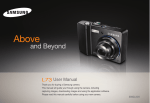
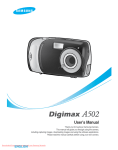
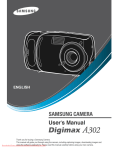
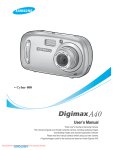
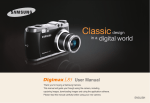

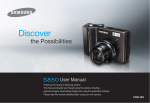
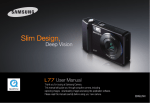
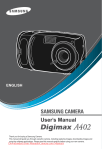
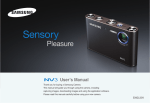

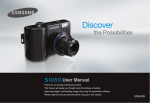
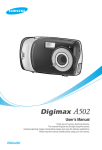


![hank yo_fo buyil_gaSamsung (}a_Te_a ]hs](http://vs1.manualzilla.com/store/data/005691502_1-2e8e29ffb67d0c8f7d0d701e3cb644b7-150x150.png)


